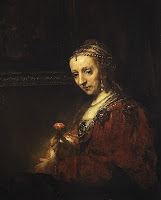Friday, January 9th, 2009
Rembrandt and Economic Slumps
 There is an interesting article in today’s edition of the New York Times that discusses the downside of Rembrandt’s career during hard economic times in the Dutch Republic. As the writer of this article mentioned, it’s interesting to examine these paintings right now, since we are also in the midst of an economic crisis.
There is an interesting article in today’s edition of the New York Times that discusses the downside of Rembrandt’s career during hard economic times in the Dutch Republic. As the writer of this article mentioned, it’s interesting to examine these paintings right now, since we are also in the midst of an economic crisis.
This is a reproduction of Rembrandt’s Woman with a Pink (early 1660s) that is discussed near the end of the article. I particularly enjoyed the writer’s thoughts regarding this painting. I also didn’t know that X-rays indicate that a child was originally included in the composition, but then painted out. This painting is one of the writer’s favorite works at the Met, and I can see why. It’s quite stunning.
Really cool article! Thanks for bringing it to my attention.
How do x-rays work in terms of seeing the original layout of paintings?
Good question, Emilee. X-rays can work in a bunch of different ways to determine original painting compositions. Often, x-rays are used to sense density, so denser areas of the canvas (where artists painted over their original composition) can be easily found. The x-rays then make a visual image of this density, which reveals the original forms.
I know that x-rays can also be used to sense different chemical makeup in paints, which can help determine a date for when the paint was applied.
I found a couple x-rays of paintings on this site:
http://www.artexpertswebsite.com/pages/research-pages/xray.php
It’s kind of fun to see what artists have painted over!
Wow, that is fascinating! As the amazing art historian that you are, do you ever wish the artists hadn’t painted over their original works? For example, I’m looking at Rembrandt’s “Tobias and the Angel” and the portrait of the man looks like it was (or could have been) very beautiful.
I also think it’s very interesting what the x-rays look like — the x-ray of Vermeer’s “The Girl With a Pearl Earring” (which is a painting I’ve always really liked)looks like a piece of art in and of itself.
I agree, I think that “Tobias and the Angel” could have turned out very beautiful. I can’t think of any of paintings, though, where I prefer the original composition over the final version. I think this is partially because one can’t get a good sense of original color with an x-ray, so it’s hard to say if I would have liked the original color scheme or paint application.
If I ever do find an x-ray of an original composition that I like better than the final painting, I’ll definitely blog about it! 🙂
What about the other art historians out there? Are there x-rays of original compositions that you prefer over the final product?